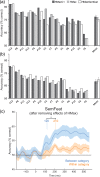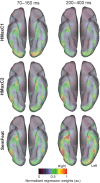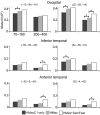Predicting the Time Course of Individual Objects with MEG
- PMID: 25209607
- PMCID: PMC4269546
- DOI: 10.1093/cercor/bhu203
Predicting the Time Course of Individual Objects with MEG
Abstract
To respond appropriately to objects, we must process visual inputs rapidly and assign them meaning. This involves highly dynamic, interactive neural processes through which information accumulates and cognitive operations are resolved across multiple time scales. However, there is currently no model of object recognition which provides an integrated account of how visual and semantic information emerge over time; therefore, it remains unknown how and when semantic representations are evoked from visual inputs. Here, we test whether a model of individual objects--based on combining the HMax computational model of vision with semantic-feature information--can account for and predict time-varying neural activity recorded with magnetoencephalography. We show that combining HMax and semantic properties provides a better account of neural object representations compared with the HMax alone, both through model fit and classification performance. Our results show that modeling and classifying individual objects is significantly improved by adding semantic-feature information beyond ∼200 ms. These results provide important insights into the functional properties of visual processing across time.
Keywords: Classification; HMax; model fit; object recognition; semantics.
© The Author 2014. Published by Oxford University Press.
Figures







References
Publication types
MeSH terms
Grants and funding
LinkOut - more resources
Full Text Sources
Other Literature Sources

